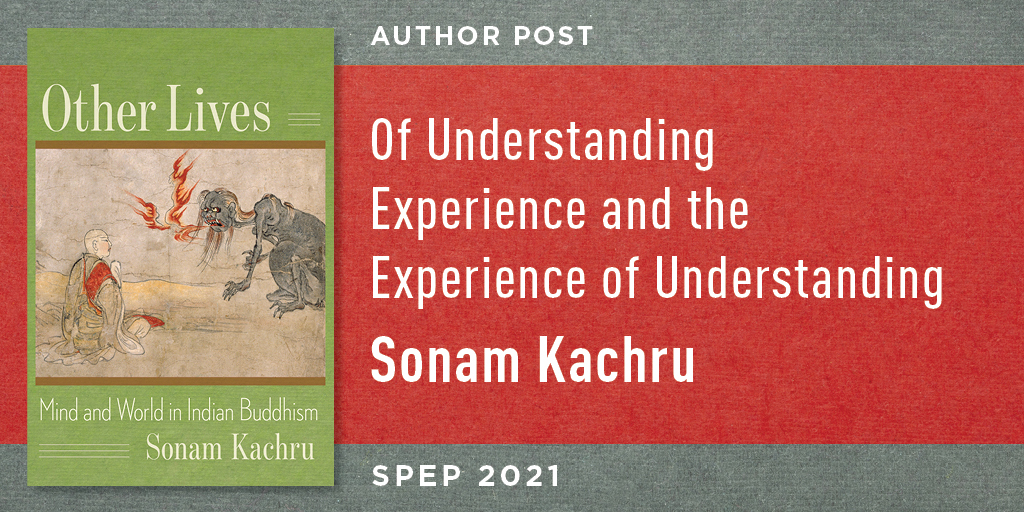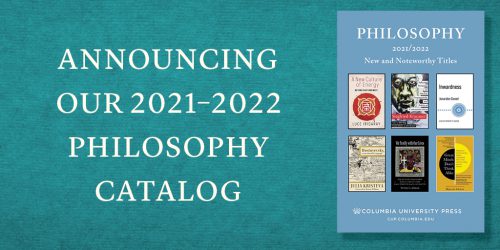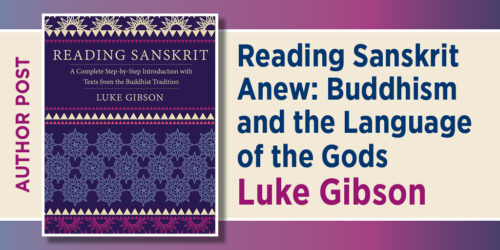Of Understanding Experience and the Experience of Understanding By Sonam Kachru

Time was when the words of Vasubandhu, the influential Buddhist philosopher from Peshawar (fl. late fourth–early fifth centuries C.E.), could be imagined to be part of the ecology of a place—as when the Sanskrit poet Bāṇabhaṭṭa intimated that Vasubandhu’s Treasury of [Buddhist] Metaphysics was so popular, so often debated and discussed, that even the parrots in one medieval Buddhist hermitage had learned to recite it. The birds of North India no longer remember him. But it is nevertheless some comfort that to this day Vasubandhu’s works remain on the curriculum of devout Buddhists from several traditions in many different parts of the world. Increasingly, they’re beginning to find a place in Anglophone classrooms where philosophy without borders is practiced.
To enter a work by Vasubandhu—whether we’re talking about one of his monumental works, his much shorter essays, or his genre-defying works like The Twenty Verses—is to enter a labyrinth. The Twenty Verses won’t take you long to read. (You could do it in an hour.) But one can spend a lifetime with the work without ever exhausting it. After more than eighteen years studying it, thinking about it, rereading it, talking about it, shelving it, returning to it, taking notes on it, sometimes (all too infrequently, alas) teaching it, all the while still lost within it, I’ve written a book—an essay, really, in the old sense of that word—about a very small part of it. Born out of growing incomprehension rather than certainty and embodying a variety of wondering perplexity, my book is called Other Lives: Mind and World in Indian Buddhism. I’d like to tell you about it.
Other Lives is primarily concerned with the examples of alternating and alternate contexts of experience with which Vasubandhu begins The Twenty Verses, including cases of perceptual error, immersive experiences in dreams, and the experiences of different life-forms as conceived of in Buddhist cosmology—hungry ghosts, beings suffering in hell, and beings tasked with inflicting torment there. I argue that these examples constitute a conceptual laboratory of sorts, allowing Vasubandhu to discern and to develop the following idea: to have experiences as of a world involves being the kind of being that is fitted to the environment one’s actions have contributed to making. In perceptual experiences we are being put in touch with history, the history of what we have made of the world and what we have made of ourselves; to put the point differently, collective possibilities for experience are principally grounded in habituation to collective patterns of activity.
On my account, Vasubandhu uses Buddhist cosmology to question any unthinking reliance on human waking experience as a norm.
Anthropologists will recognize such a view. Think, for example, of those who believe that proclivity, practice, and interaction (to quote Tanya Luhrmann) “shape the most basic ways we encounter our world.” In future, iterations of such views might call on Vasubandhu for support, though, to be sure, Vasubandhu wasn’t thinking anthropologically, but cosmologically. The epistemological challenge, nevertheless, is similar: How are we to bring the insights we find easy to acknowledge with respect to other forms of life and their worlds to bear on our own way of experiencing a world?
On my account, Vasubandhu uses Buddhist cosmology to question any unthinking reliance on human waking experience as a norm. His examples help to show that the typically unmarked view from the perspective of a normal, wakeful human individual is not truly a “view from nowhere.” Waking experience is not exhaustive of possible experience, given that we are diurnal creatures, alternating between waking and dreaming contexts; and human experience is not exhaustive of possible forms of experience, given the other possible forms of life (some Buddhists believe) we shall experience through rebirth. When thinking about living beings, Buddhist cosmology teaches that variation ought to be seen to be constitutive: no one type of living being exhausts what life involves; nor is any one context of possible experience sufficient. We should not, then, center our account of ourselves using vocabularies grounded in only one possible form of experience or only one form of life. Our understanding of other life-forms and their contexts of experience ought to constrain our understanding of our own.
This is the seed for Other Lives. But there’s more. I’m interested in Vasubandhu’s understanding of experience; but I am also interested in the experience of understanding—what it is like to experience thought and understanding when we are sensitized to the affective textures, savors, and moods serving to scaffold thought in another intellectual tradition or text.
Texts can be intellectual environments in which certain kinds of experiences and attitudes to the world are enacted and sustained.
Texts can be intellectual environments in which certain kinds of experiences and attitudes to the world are enacted and sustained. As discussed at some length in Malcolm David Eckel’s superb To See a Buddha, Bhāviveka, a Buddhist philosopher who lived many centuries after Vasubandhu, asked his readers in his Verses on the Heart of the Middle Way to think of reality as a tower with a staircase for ascent. That’s a helpful image. It can make sense of the organization of a philosophical text along with one’s movement or epistemic progression through it. Vasubandhu, to the best of my knowledge, offers us no such image, though he once helpfully characterized the different ways one might experience what is involved in understanding something in terms of the difference it can make for a horse and rider to go over familiar rather than unfamiliar terrain. For sheer diversity of conceptual (and very likely unfamiliar and challenging) terrain found in a short work, The Twenty Verses is hard to match. What does that do for one’s experience of the work? And what epistemic role, if any, might such experiences serve? I’ve ventured into this dimension of intellectual history by all too briefly appealing to wonder, as evoked by Vasubandhu and as theorized in Sanskrit literary culture more broadly. Other Lives also includes a translation of The Twenty Verses for readers who wish to explore this wonder of a philosophical work for themselves.
There it is: Vasubandhu suggests that we cannot understand ourselves without taking alternate contexts of experience into account. I think that we cannot fully understand ourselves without sensitizing ourselves to more intellectual contexts and to a more capacious view of the history of philosophy than we currently possess. Vasubandhu thought hell was good to think with; I think that Vasubandhu is good to think with as well. Though one just might want to do some things differently.
In his History of Buddhism in India, the seventeenth-century Tibetan scholar Tāranātha describes how Vasubandhu once took to soaking himself in a bath of sesame oil for fifteen uninterrupted days and nights. He did so in order to read a small library’s worth of Buddhist scripture. Speed-read, I should say—Tāranātha tells us that it would have taken anyone else a year to get through as much with any hope of comprehension. Why exactly such a lengthy immersion in fragrant oil was necessary for Vasubandhu to accomplish this feat of extreme scholarship is a question best left to Vasubandhu—or perhaps to his doctor. Other Lives, I hasten to say, is a much quicker, much less demanding read. It doesn’t ship with bath oils, but I hope that reading it may still offer readers a rejuvenating intellectual experience.
Sonam Kachru is assistant professor in the Department of Religious Studies at the University of Virginia. He is the author of Other Lives: Mind and World in Indian Buddhism.








